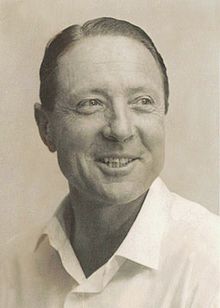Harry Christian Giese AM, MBE (9 December 1913 – 4 February 2000) administered Australian federal government policy for the people of the Northern Territory under Prime Ministers including Robert Menzies and Harold Holt and Ministers including Paul Hasluck.
Harry C. Giese | |
|---|---|
 Harry C. Giese in the 1970s | |
| Born | 9 December 1913 |
| Died | 4 February 2000 (aged 86) Darwin, Northern Territory, Australia |
| Occupation(s) | Australian administrator, public servant and community leader |
| Partner | Nancy (Nan) Giese |
| Website | http://www.harrychristiangiese.com.au |
Biography and career edit
Giese was a third-generation descendant of a German family who migrated to Australia in the 1870s.[1][2][3][4] In 1954, after senior public service jobs in Western Australia and Queensland,[5] he moved to Darwin as the Director of Welfare in the Northern Territory Administration.[6][7] He was the longest-serving member of the Northern Territory Legislative Council, from 1954 to 1973.
After Cyclone Tracy Giese headed the Darwin Disaster Welfare Council and in 1978, after Territory self-government, he became the first Northern Territory Ombudsman.[8][9][10]
As founding Chairman of the NT Committee of the Menzies Foundation he was instrumental in the establishment of the Menzies School of Health Research,[11][12] serving on its Board of Governors and as Deputy Chairman from 1985 to 1995. The School is now one of Australia's leading medical research institutes, and a global leader in tropical research into life-threatening illnesses. Harry Giese's obituary in the Menzies Foundation Annual Report 1999 said that ‘the continuing contribution made...to the health of northern Australians is a tribute to the vision, the enthusiasm and the advocacy of Harry Giese, who first identified the need for such a School, and who later vigorously pursued its establishment and strongly supported its work.'
He was made a Member of the Order of Australia and an Honorary Fellow of the University of Sydney.
Giese was Foundation President and honorary Life Member of numerous community service and sporting organisations, including the Royal Life Saving Society Australia, Darwin Probus Club, Darwin Disaster Welfare Council after the 1974 destruction of Cyclone Tracy, and the Institute of Public Administration.[13][14]
References edit
- ^ Entry in Northern Territory Dictionary of Biography. Charles Darwin University, 2008.
- ^ Who's Who in Australia. Herald and Weekly Times. 1977–2000.
- ^ "Mr E.A. Giese". Western Mail. Perth, WA: National Library of Australia. 21 December 1907. Retrieved 11 October 2013.(grandfather's funeral, 1907)
- ^ "Struck by Falling Tree, Man Fatally Injured". Western Argus. National Library of Australia. 29 November 1927. Retrieved 11 October 2013.(father's accidental death, 1927)
- ^ "Sporting Round-Up: Fitness Officer's Record". The West Australian. Perth: National Library of Australia. 31 August 1950. Retrieved 11 October 2013.(early jobs)
- ^ "Planning a program for Aborigines in the 1950s". Northern Territory Library Service. 1990. Retrieved 11 October 2013.
- ^ Northern Territory Administration. "Welfare Branch Annual Reports, 1954–1972". Canberra: Australian Government Publishing Service. Retrieved 11 October 2013.
- ^ "Northern Territory Ombudsman First Report, date 1 July 1978 – 27 October 1978".
- ^ "Northern Territory Ombudsman, Australian and Pacific Regional Information Manual, 2009, page 24 (19)" (PDF).
- ^ "[Biographical cuttings on Harry Giese, containing one or more cuttings from newspapers or journals] - Catalogue | National Library of Australia". catalogue.nla.gov.au. Retrieved 2 February 2024.
- ^ Wrigglesworth, E.C. (1969). The Sir Robert Menzies Memorial Trust and Foundation: The First Fifteen Years. Melbourne: Menzies Foundation.
- ^ "Harry Christian Giese, AM, MBE, Menzies Foundation Annual Report 1999, Pages 11-13".
- ^ See Annual Reports and President’s Report of all organisations from the 1950s to 2000 and beyond.
- ^ Northern Territory Archives Service, Darwin | NTRS 226, Oral History interviews transcript 755.
Further reading edit
- H.C. Giese, Director of Welfare, Partnership towards Aboriginal Progress, in Focus 70 supplement, Northern Territory News, March 1970
- Personal papers relating to government administration in welfare and Aboriginal affairs, 1929–86, NTRS 1043/P1, Northern Territory Archives Service, Darwin
- Welfare Branch Annual Reports, 1954–1972, Northern Territory Administration, AGPS, Canberra at 15 Australian libraries; see http://trove.nla.gov.au/work/12488134?versionId=14755357
- Harry Giese, interviews April 1987 – September 1991, NTRS 226, TS 755, Northern Territory Archives Service, Darwin
- Menzies Foundation Annual Reports, including pages 11–13 of the 1999 Annual Report
- Annual Reports and President's Report of community organisations such as the Royal Life Saving Society at https://www.royallifesaving.com.au/nt/About-Royal-Life-Saving-NT
- Menzies School of Health Research, 30 years of supporting Indigenous health and medical research https://www.menziesfoundation.org.au/menzies-legacy-projects/health-research, https://www.menzies.edu.au/page/Menzies_30th/Our_Journey, https://www.menzies.edu.au/page/About_Us/Achievements/